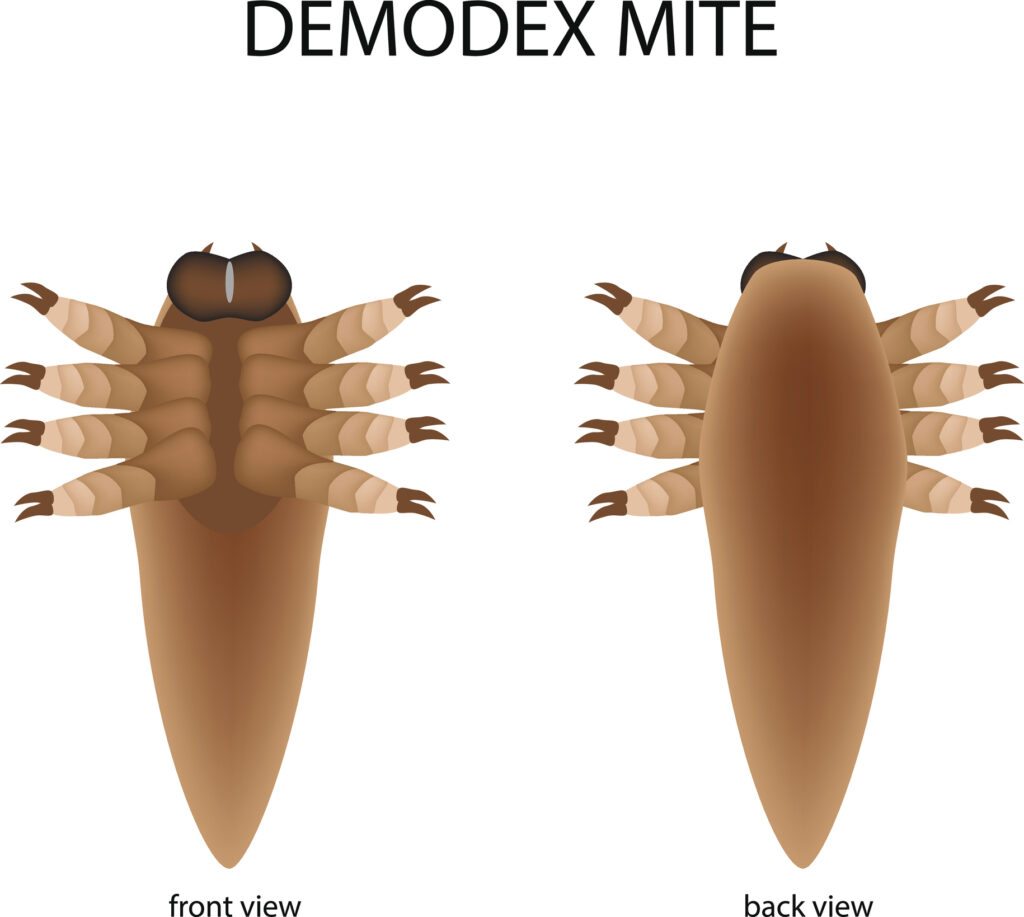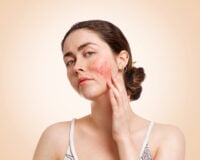Did you know that rosacea, an inflammatory skin condition that primarily affects the face, is common in about 10% of the population? More likely to occur in fair skinned individuals, it’s often referred to as acne rosacea if accompanied by pustules and small white heads. Rosacea usually makes its first appearance between the ages of 35 to 50, so some of your middle aged patients may think that their acne days are long gone, only to be hit with the following symptoms:
- Facial flushing
- Permanent redness of the face
- Telangiectasia (broken capillaries)
- Enlarged capillaries
- Small yellow or pus-filled whiteheads that look like acne
- Small red bumps
- Stinging or burning sensation of the skin
- Patches of dry skin
- Eye irritation, dry or sensitive eyes
- Irritation of the scalp

What causes rosacea?
The exact pathophysiology is still under investigation and involves various contributing factors, such as genetics, immune dysregulation, microorganism overgrowth (such as small intestinal bacteria overgrowth [SIBO] and demodex mite), environmental factors and vascular dysregulation. There appears to be an aggravated immune and/or inflammatory response that can lead to a disruption in blood vessel homeostasis as well as increased reactive oxygen species-induced damage to keratinocytes and endothelial cells.
This mite cause rosacea
One of the more interesting causes of rosacea is the demodex mite, a tiny eight-legged inhabitant of the hair follicles, eyelashes and pilosebaceus units on the face and scalp. These little mites feed on sebum, cellular proteins, cosmetics and hormones – yum! Although this may sound horrifying, demodex are found on the skin of most healthy people and only become a problem if their numbers creep too high. They are thought to play a role in rosacea as they can block hair follicles, piggyback inflammatory bacteria around and trigger inflammation, immune dysfunction and breakdown of the skin barrier.

Symptoms of demodex overgrowth include:
- Dryness
- Pustules, acne-like lesions
- Itching of the face and scalp
- Hypersensitivity of the facial skin
- Blepharitis and eyelid dermatitis
- Rosacea with pustules and scaling
Diagnosis is often made via skin scraping or viewing the number of mites on a sample under a microscope. However, in many cases it may be easier to go by the patient’s symptoms.
Prevention and treatment involves washing the face twice a day, avoiding oily cleansers and greasy makeup, changing pillowcases and towels at least twice per week and using diluted tea tree oil to kill them off. A healthy lifestyle may also assist, since demodex numbers are increased in patients with low immunity, obesity, high blood sugar levels and in chronic renal failure.
Saving face with herbal medicine
Rosacea can be complex, however soothing herbal formulas may come to the rescue! A blend of cleavers, BCM-95™ turmeric, dandelion, burdock, and grape seed extract can enhance tissue repair and quell skin inflammation. These herbs reduce oxidative damage, modulate immunity, decrease opportunistic inflammatory skin bacteria and support lymphatic clearance.1,2,3,4
Grapeseed extract can protect delicate capillaries from damage and may improve vascular structure. This makes it a good choice when dealing with skin conditions like rosacea, where there is often vascular dysregulation and capillary fragility.
Other factors for success
Some patients may find that symptoms can be improved by avoiding alcohol, spicy food, hot food and drinks, as well as reducing heavy or waterproof cosmetics. Humectant moisturisers and sunscreen should also be applied daily to protect the skin barrier. Finding the cause can be tricky, however treating symptoms with traditional herbal remedies, improving the diet and considering overgrowth of mites or bacteria may help your patients to overcome rosacea.
References
1 Hu G, Wang J, Hong D, et al. Effects of aqueous extracts of Taraxacum officinale on expression of tumor necrosis factor-alpha and intracellular adhesion molecule 1 in LPS-stimulated RMMVECs. BMC Complement Altern Med. 2017;17(1):38. doi:10.1186/s12906-016-1520-3
2 Al-Snafi, Ali. (2018). Chemical constituents and medical importance of galium aparine-a review. Indo Am Journal Pharm Sci. 05(03, 1739-1744. ttp://doi.org/10.5281/zenodo.1210517
3 Miazga-Karska M, Michalak K, Ginalska G. Anti-acne action of peptides isolated from burdock root-preliminary studies and pilot testing. Molecules. 2020;25(9):2027. doi:10.3390/molecules25092027
4 Knott A, Reuschlein K, Mielke H, et al. Natural arctium lappa fruit extract improves the clinical signs of aging skin. J Cosmet Dermatol. 2008 Dec;7(4):281-9. doi: 10.1111/j.1473-2165.2008.00407.x









Leave a Comment